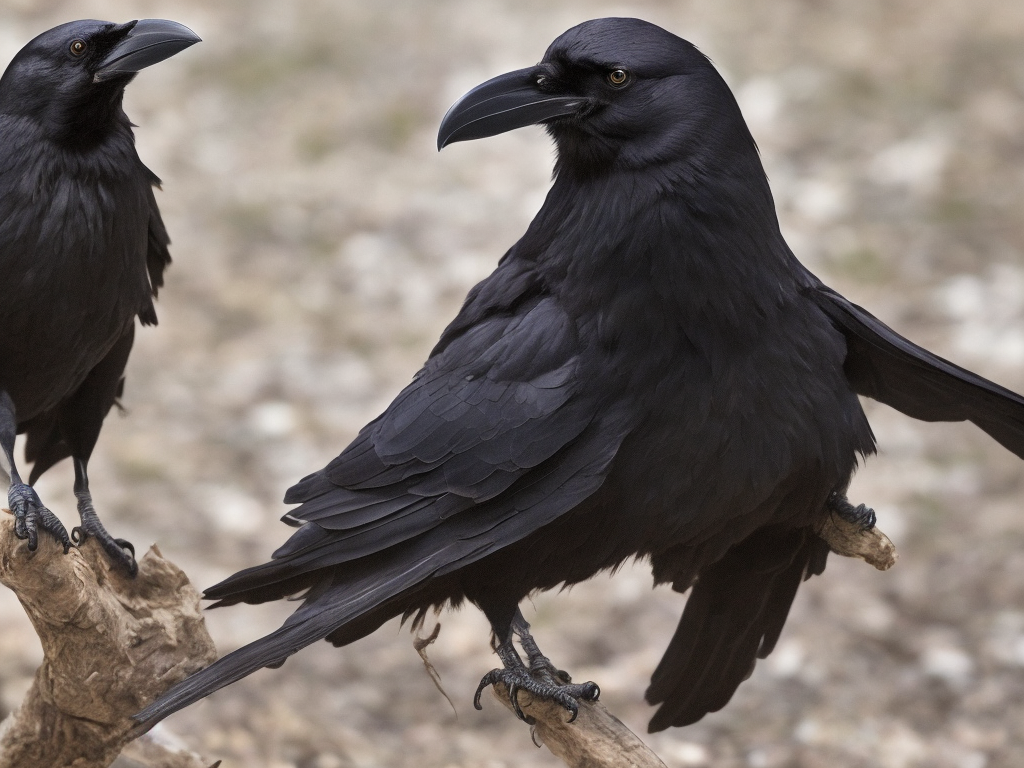
Crows and Ravens are highly intelligent and adaptable birds that are often found in urban environments around the world. At first glance, they may appear to be similar birds, but there are some significant differences between the two that set them apart from each other.
One of the most noticeable differences between Crows and Ravens is their size. Ravens are generally larger than Crows, with an average wingspan of around 4 feet and a body length of up to 2 feet. While Crows are smaller, with an average wingspan of about 3 feet and a body length of around 1.5 feet. Another way to distinguish between the two is by examining their tail feathers. Ravens have a wedge-shaped tail while Crows have a more fan-shaped tail.
Both Crows and Ravens have a distinctive black feather coloration. However, Ravens have a more metallic shine to their feathers while Crows have a more uniform color. Ravens also have throat feathers that are fluffier than Crows and which produce a distinctive "croaking" sound.
The differences in size and physical features aren't the only contrasts between these two birds. The following is a list of some of the most significant differences between Crows and Ravens.
Habitat
Ravens are larger than Crows and prefer to reside in open landscapes such as farming areas and mountainside habitats. Ravens root out their food using their powerful beaks and claws. They consume larger prey such as small mammals, insects, and bird eggs, which they may store to eat later. Ravens favor nesting on high cliffs, while Crows are seen around open fields and woodlands. They feed on insects, fruits, and seeds and are more adaptable to living in urban environments.
Calls
Another distinction between Ravens and Crows is their calls. Ravens are known for their deep and guttural "gronk gronks," while Crows have a higher-pitched and less harsh "caw caws." Additionally, Crows make a larger variety of sounds and usually maintain only one call with their family and one for general use.
Different Psychologies
Crows are intelligent, social birds who work alongside their relatives to protect their territories and food sources. They make and use tools and play games with one another. The longer beak of a crow allows it to probe or extract hidden food from its habitat. They have also been observed playing with other animals and human objects, such as small plastic toys or shiny objects.
Ravens are also intelligent creatures. They can use tools and also play games, but they have a greater tendency to use tools in more elaborate ways. Studies have shown that Ravens perform better in problem-solving experiments and have a remarkable memory. Ravens have also been observed using their intelligence to trick other birds out of their food.
In folklore and mythology
Ravens have a strong connection to mythology and folklore. They have been used in stories to symbolize intelligence, wisdom, and even death in various cultures worldwide. The Norse god Odin was believed to be accompanied by two ravens, Huginn and Muninn, who served as his eyes and ears. In Celtic folklore, they were known as messengers of the gods and were said to have played an integral role in the creation of the world.
Crows, on the other hand, are often viewed as symbols of bad luck, misfortune, and death in many cultures. They have been associated with witches and the occult and have often been depicted in horror movies, reinforcing their negative image. However, in some cultures, they have been viewed positively, such as in Native American mythology, where they were considered to be messengers of positive change.
To sum up, Crows and Ravens are both intelligent birds that have adapted well to urban life. They are often found in the proximity of each other, causing confusion as to which bird is which. Ravens are larger, with a more wedge-shaped tail, and prefer open landscapes and larger prey. Crows are smaller, have a fan-shaped tail, and are more adaptable to living in urban environments. These birds have different calls and psychologies. Moreover, they have played a significant role in mythology and folklore worldwide.
 Self-Instruct
Self-Instruct